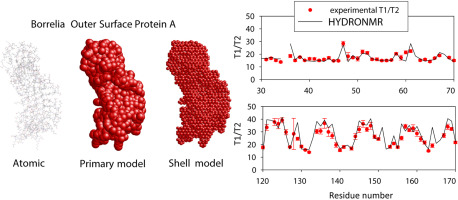当前位置:
X-MOL 学术
›
J. Mol. Biol.
›
论文详情
Our official English website, www.x-mol.net, welcomes your
feedback! (Note: you will need to create a separate account there.)
Hydrodynamic Properties of Biomacromolecules and Macromolecular Complexes: Concepts and Methods. A Tutorial Mini-review.
Journal of Molecular Biology ( IF 4.7 ) Pub Date : 2019-12-23 , DOI: 10.1016/j.jmb.2019.12.027 J García de la Torre 1 , J G Hernández Cifre 1
Journal of Molecular Biology ( IF 4.7 ) Pub Date : 2019-12-23 , DOI: 10.1016/j.jmb.2019.12.027 J García de la Torre 1 , J G Hernández Cifre 1
Affiliation

|
This article is intended to be an overview of the current possibilities offered by hydrodynamic methods in the calculation of properties and prediction of the behavior of biomacromolecules in solution. First, we briefly cover the experimental techniques, mentioning their fundamentals and current status. Using a tutorial approach, we provide basic hints to understand conceptual aspects of macromolecular hydrodynamics which underlie the instrumental methods and the modeling and computational procedures. The description is focused on the bead model methodology as implemented in the HYDRO suite of computer programs. For rigid particles, we cover simple models, such as ellipsoids and cylinders, to the most detailed models with atomic resolution. The fundamentals and applicability of the basic random coil and wormlike models for flexible particles are also briefly described. In addition to the simple linear, more or less flexible chain, flexibility may appear in other more specific forms. These cases can be treated by Monte Carlo and Brownian simulation methods, for which computational tools are also available. Finally, we present in some detail the applicability of these tools for unfolded and intrinsically disordered proteins. For the particular case of partially disordered proteins comprising both globular domains and flexible linkers or tails, solution properties can be accurately predicted, and this validation makes the methodology quite promising for future work.
中文翻译:

生物大分子和高分子复合物的流体力学性质:概念和方法。教程迷你复习。
本文旨在概述流体力学方法在计算性质和预测溶液中生物大分子行为时提供的当前可能性。首先,我们简要介绍实验技术,并介绍它们的基本原理和当前状态。通过使用教程方法,我们提供了基本的提示,以了解大分子流体动力学的概念方面,这些方面是仪器方法以及建模和计算过程的基础。该描述集中于在HYDRO计算机程序套件中实现的磁珠模型方法。对于刚性粒子,我们将简单的模型(例如椭圆体和圆柱体)涵盖到具有原子分辨率的最详细的模型中。还简要描述了用于柔性颗粒的基本随机线圈和蠕虫状模型的基本原理和适用性。除了简单的线性或多或少的柔性链,柔性还可以以其他更具体的形式出现。这些情况可以通过蒙特卡洛和布朗仿真方法进行处理,对于这些情况,也可以使用计算工具。最后,我们更详细地介绍了这些工具对未折叠和本质上无序的蛋白质的适用性。对于包含球形结构域和柔性接头或尾部的部分无序蛋白的特殊情况,可以准确预测溶液的性质,这种验证使该方法对于未来的工作很有前景。灵活性可能会以其他更具体的形式出现。这些情况可以通过蒙特卡洛和布朗仿真方法进行处理,对于这些情况,也可以使用计算工具。最后,我们更详细地介绍了这些工具对未折叠和本质上无序的蛋白质的适用性。对于包含球形结构域和柔性接头或尾部的部分无序蛋白的特殊情况,可以准确预测溶液的性质,这种验证使该方法对于未来的工作很有前景。灵活性可能会以其他更具体的形式出现。这些情况可以通过蒙特卡洛和布朗仿真方法进行处理,为此也可以使用计算工具。最后,我们更详细地介绍了这些工具对未折叠和本质上无序的蛋白质的适用性。对于包含球形结构域和柔性接头或尾部的部分无序蛋白的特殊情况,可以准确预测溶液的性质,这种验证使该方法对于未来的工作很有前景。
更新日期:2019-12-25
中文翻译:

生物大分子和高分子复合物的流体力学性质:概念和方法。教程迷你复习。
本文旨在概述流体力学方法在计算性质和预测溶液中生物大分子行为时提供的当前可能性。首先,我们简要介绍实验技术,并介绍它们的基本原理和当前状态。通过使用教程方法,我们提供了基本的提示,以了解大分子流体动力学的概念方面,这些方面是仪器方法以及建模和计算过程的基础。该描述集中于在HYDRO计算机程序套件中实现的磁珠模型方法。对于刚性粒子,我们将简单的模型(例如椭圆体和圆柱体)涵盖到具有原子分辨率的最详细的模型中。还简要描述了用于柔性颗粒的基本随机线圈和蠕虫状模型的基本原理和适用性。除了简单的线性或多或少的柔性链,柔性还可以以其他更具体的形式出现。这些情况可以通过蒙特卡洛和布朗仿真方法进行处理,对于这些情况,也可以使用计算工具。最后,我们更详细地介绍了这些工具对未折叠和本质上无序的蛋白质的适用性。对于包含球形结构域和柔性接头或尾部的部分无序蛋白的特殊情况,可以准确预测溶液的性质,这种验证使该方法对于未来的工作很有前景。灵活性可能会以其他更具体的形式出现。这些情况可以通过蒙特卡洛和布朗仿真方法进行处理,对于这些情况,也可以使用计算工具。最后,我们更详细地介绍了这些工具对未折叠和本质上无序的蛋白质的适用性。对于包含球形结构域和柔性接头或尾部的部分无序蛋白的特殊情况,可以准确预测溶液的性质,这种验证使该方法对于未来的工作很有前景。灵活性可能会以其他更具体的形式出现。这些情况可以通过蒙特卡洛和布朗仿真方法进行处理,为此也可以使用计算工具。最后,我们更详细地介绍了这些工具对未折叠和本质上无序的蛋白质的适用性。对于包含球形结构域和柔性接头或尾部的部分无序蛋白的特殊情况,可以准确预测溶液的性质,这种验证使该方法对于未来的工作很有前景。











































 京公网安备 11010802027423号
京公网安备 11010802027423号